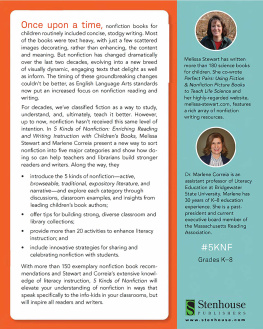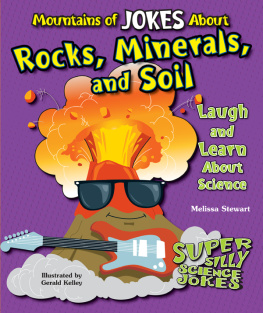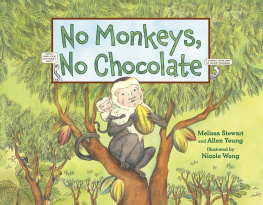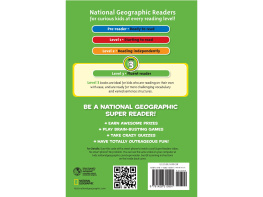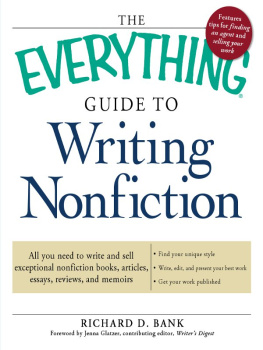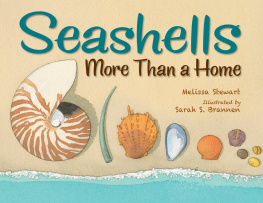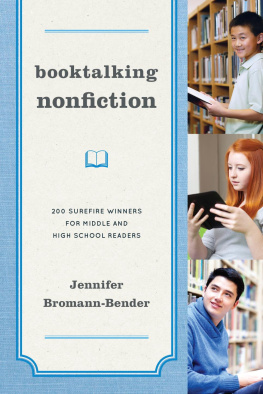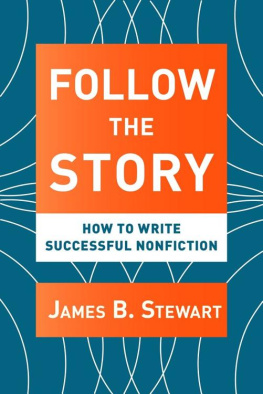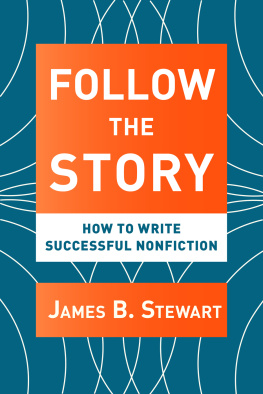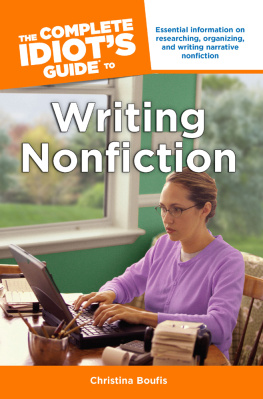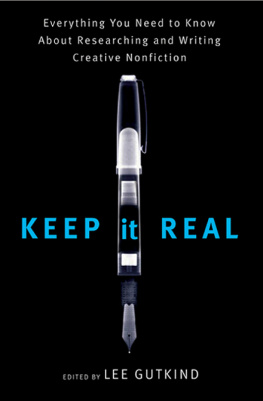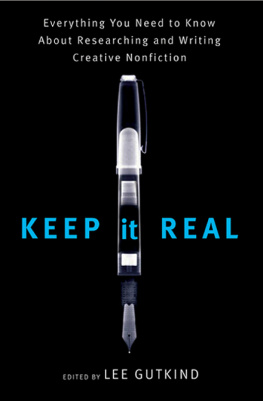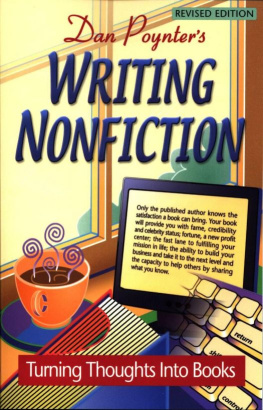.
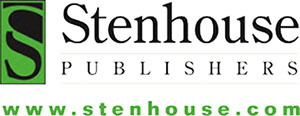
Stenhouse Publishers
www.stenhouse.com
Copyright 2021 by Melissa Stewart and Marlene Correia
All rights reserved. This e-book is intended for individual use only. You can access this e-book on multiple personal devices (i.e. computer, e-reader, smartphone). You may not reproduce digital copies to share with others, post a digital copy on a server or a website, make photocopies for others, or transmit in any form by any other means, electronic or mechanical, without permission from the publisher.
Every effort has been made to contact copyright holders and students for permission to reproduce borrowed material. We regret any oversights that may have occurred and will be pleased to rectify them in subsequent reprints of the work.
Library of Congress Cataloging-in-Publication Data
Names: Stewart, Melissa, author. | Correia, Marlene P., author.
Title: 5 kinds of nonfiction: enriching reading and writing instruction with childrens books / Melissa Stewart and Marlene Correia.
Other titles: Five kinds of nonfiction
Description: Portsmouth, New Hampshire : Stenhouse Publishers, [2021] | Includes bibliographical references and index. |
Identifiers: LCCN 2020009854 (print) | LCCN 2020009855 (ebook) | ISBN 9781625314178 (paperback) | ISBN 9781625314185 (ebook)
Subjects: LCSH: English languageComposition and exercisesStudy and teaching (Elementary) | Childrens books. | School childrenBooks and reading.
Classification: LCC LB1576 .S7964 2020 (print) | LCC LB1576 (ebook) | DDC 372.6/044dc23
LC record available at https://lccn.loc.gov/2020009854
LC ebook record available at https://lccn.loc.gov/2020009855
Cover design by Cindy Butler
Interior design and typesetting by Gina Poirier, Gina Poirier Design
To the many educators who have supported and contributed to my nonfiction advocacy, especially Alyson Beecher, Lesley Burnap, Mary Ann Cappiello, Michele Knott, Judi Paradis, Melanie Roy, Terrell Young, and Terrence Young. M.S.
To teachers who spark a love of literacy by never giving up the quest to discover the right book, for the right child, at the right time. M.C.
Text Permissions
Portions of this book were adapted from the following sources:
Bukowiecki, E., and M. Correia. 2017. Informational Texts in Pre-kindergarten Through Grade-Three Classrooms. Lanham, MD: Rowman & Littlefield. Used by permission of Rowman & Littlefield.
Stewart, M. 2015, December 21. Diversity in Thinking. A Fuse #8 Production/School Library Journal. Retrieved from http://blogs.slj.com/afuse8production/2015/12/21/guest-post-melissa-stewart-and-diversity-in-thinking/. Used by permission of Elizabeth Bird and School Library Journal.
Stewart, M. 2016, Fall. What the Heck Is an Informational Book? The SCBWI Bulletin, 2122. Used by permission of the Society of Childrens Book Writers and Illustrators.
Stewart, M. 2017, September 21. A Look at Expository Literature. A Fuse #8 Production/School Library Journal. Retrieved from http://blogs.slj.com/afuse8production/2017/09/21/guest-post-melissa-stewart-a-look-at-expository-literature/. Used by permission of Elizabeth Bird and School Library Journal.
. 2018, May. The Five Kinds of Nonfiction. School Library Journal, 1213. Used by permission of School Library Journal.
. 2020, August. Expository vs. Narrative Nonfiction. School Library Journal, 16. Used by permission of School Library Journal.
. 2020, Fall. Voice in Nonfiction Writing, The SCBWI Bulletin, 1921. Used by permission of the Society of Childrens Book Writers and Illustrators.
Stewart, M., and T. A. Young. 2018. Defining and Describing Expository Literature. In Does Nonfiction Equate Truth? Rethinking Disciplinary Boundaries Through Critical Literacies, ed. V. Yenika-Agbaw, R. M. Lowery, and L. A. Hudock (1124). Lanham, MD: Rowman & Littlefield. Used by permission of Rowman & Littlefield.
. 2019. Teaching the Key Traits of Expository Nonfiction with Childrens Books. The Reading Teacher 72 (5): 648651. Used by permission of John Wiley and Sons.
CONTENTS
Acknowledgments
We gratefully acknowledge Colby Sharp for inviting Melissa to make the video that introduced the Nerdy Book Club community to the 5 Kinds of Nonfiction classification system and Valerie Bang-Jensen, Vickie Blankenship, Tom Bober, Abi Diaz, Kristen Picone, Melissa Pillot, Carole Stubeck, and Jen Vincent for being early adopters. We appreciate their willingness to do the book-sorting activities with their students and collect data about student preferences.
We would also like to thank childrens book authors Sarah Albee, Brenda Z. Guiberson, Steve Jenkins, Jess Keating, and Sara Levine for agreeing to be interviewed and educators Tom Bober, Abi Diaz, Valerie Glueck, Traci Kirkland, Ruth McKoy Lowery, Shelley Moody, Kristen Picone, Jen Vincent, and Terrence Young for providing quotations that appear in the book; childrens book authors Loree Griffins Burns and Heather Montgomery and retired school librarians Karen Kosko and Terrence Young for taking the time to read the manuscript and offer valuable suggestions; Valerie Bang-Jensen, Karen Blumenthal, and Kate Narita for offering sage advice at just the right moments; and Gerard Fairley for his assistance in securing permissions and preparing the back matter.
A special thank-you to the many educators and friends who took photos and supplied student work samples for the book, including Vickie Blankenship, Sarah S. Brannen, Catherine Burns, Ann Davis, Robin DeCosta, Jason Lewis, Kathleen Merten, Shelley Moody, Kendall Newman, Melissa Pillot, Alyssa Pimentel, Katelyn Rebello, Mary Shorey, Stacey Snyder, Donna Sullivan-McDonald, Maria Sylvain, Ann Williams, and Judy Williams. An extra shout-out to Michele Knott who supplied seventeen images!
Thank you to Terry Thompson for encouraging us to write this book and offering exemplary editorial support through the process. We are also grateful to the entire Stenhouse staff, including Shannon St. Peter, Stephanie Levy, Cindy Butler, Gina Poirier, Pamela Hunt, and Cindy Black. And finally we would like to extend a heartfelt thank-you to all the childrens book authors, illustrators, and publishers (Bloomsbury; Boyds Mills Press & Kane; Candlewick; Capstone; Charlesbridge; Chicago Review Press; Chronicle; HarperCollins; Holiday House; Houghton Mifflin Harcourt; Lerner; Little, Brown; Macmillan; National Geographic; Peachtree; Penguin Random House; Rosen; Scholastic; Simon & Schuster; Sterling; Storey; Two Lions; and What on Earth? Books) who gave us permission to use the cover images of their books free of charge.
A Note from Melissa
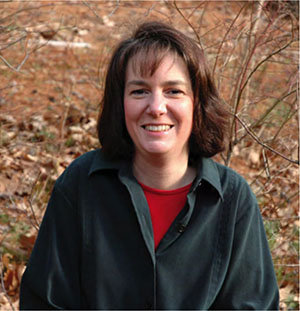
There arent many childrens book authors who have written close to 200 nonfiction books and not a single fiction title, so its no surprise that one of the most common questions children ask me during school visits is if Ill ever write fiction. For years, I gave the same answer every single time: Maybe, I just need to find the right story.
I dont know if that answer satisfied the students, but it certainly didnt satisfy me because it was a lie. You see, in my professional life, Im surrounded by people who prize stories and storytelling, and, for a long time, I thought I should too.
I remember praising the format of a particular picture book biography during a presentation at a writing conference in Texas. Later, a friend who is a celebrated childrens book author kindly pointed out that, to her, the characters in that book seemed a bit wooden. That comment, and others like it from authors, editors, and educators I respect, gradually made me realize that I dont experience stories in the same way as my colleagues. I felt like an oddball, like I was all alone in a world that valued narratives.
Next page
